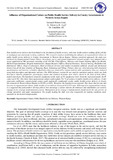| dc.description.abstract | Poor health service delivery has been linked to the devolution of health services, with some health workers walking off the job due
to inadequate pay and unsafe working conditions. This research aimed at establishing the influence of organizational culture on
public health service delivery in County Governments in Western Kenya Region, Taking a positivist approach, the study was
anchored on Organizational Culture Theory. Descriptive survey and causal-comparative research designs were adopted with a
target population of 966 personnel consisting of the CECMs, Chief Officers, Directors and County Nursing Officer for Health,
Medical Superintendents, Hospital Administrator, Human Resource Officer, Head of Pharmacy, Head of Nursing, Health Records
Information Officer, Head of Laboratory, Head of Clinical Services and number of patients admitted, treated and discharged
drawn from all the four Counties of Bungoma, Busia, Kakamega and Vihiga. Primary data was collected using both structured
questionnaires and interview schedules. Qualitative data was analysed by content analysis while quantitative data was analysed
using both descriptive and inferential statistics. The SPSS Software version 26 was used for statistical analysis which was both
descriptive whereby frequencies, percentages, means and standard deviation were clearly shown in the form of both tables,
models and charts. The hypothesis tested for significance of the study at 5% significance level. From the regression model, the R2
value was 0.761. This shows that organizational culture could explain 76.1 % of variance in public health service delivery. Under
regression coefficients, organizational culture could statistically significantly predict public health service delivery in County
Governments in Western Kenya Region (t=30.529, p<0.05). Therefore, the hypothesis was rejected. This shows that for one-unit
increase in organizational culture, public health service delivery increased by 0.873 units. With regard to organizational culture,
it is suggested that policymakers develop policies that encourage a culture wherein all employees and stakeholders are actively
engaged in the strategic implementation process. Management of the strategy's implementation should not be the sole purview of
change specialists and upper management. The people leading the shift were also responsible for making conditions more
amenable to the desired transformation. | en_US |

